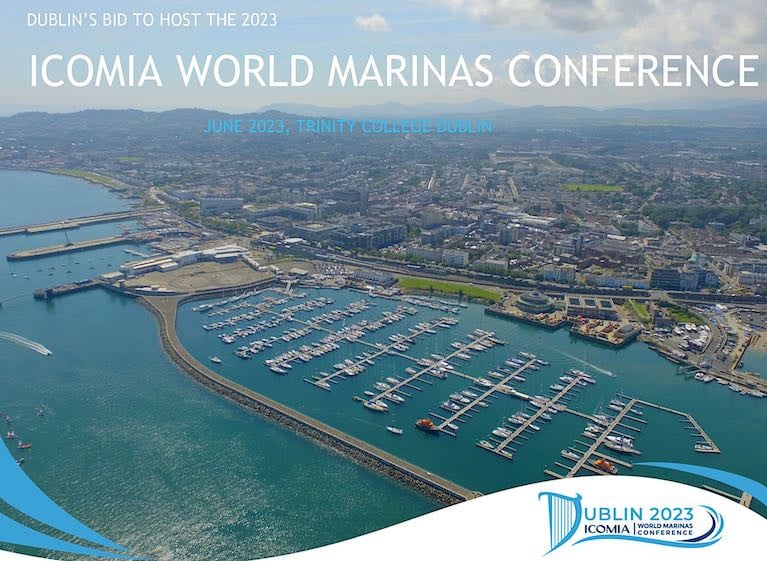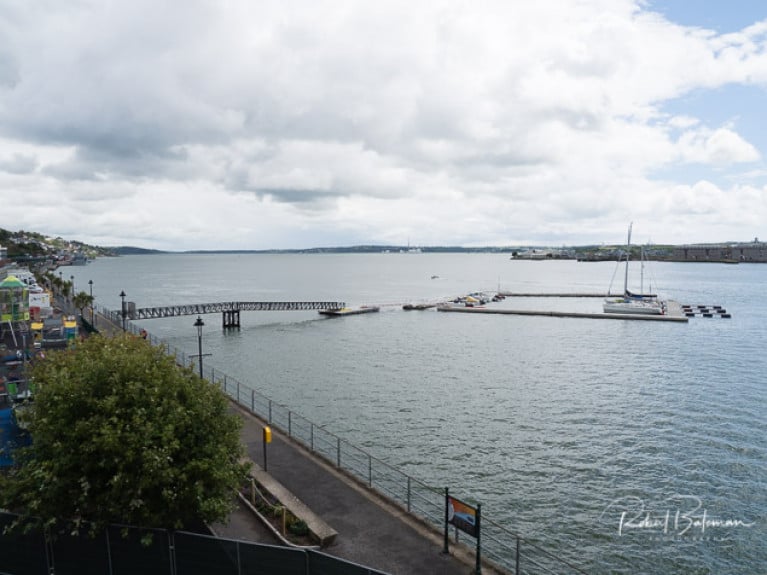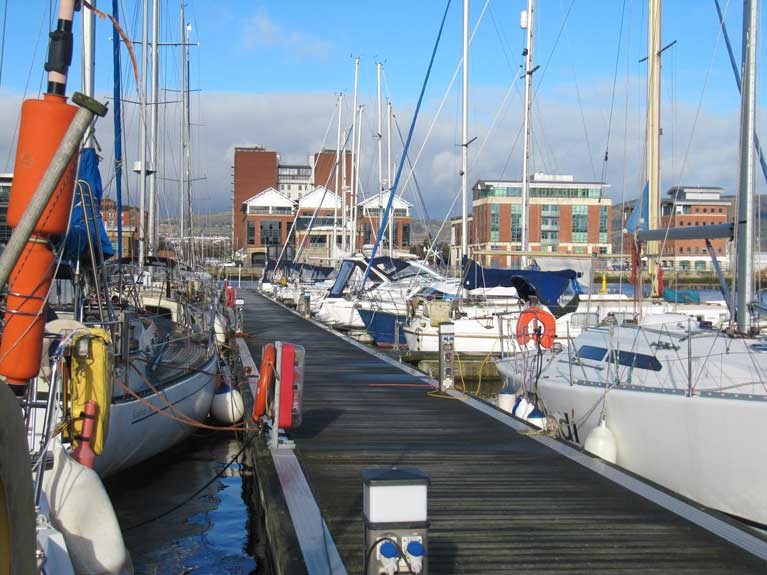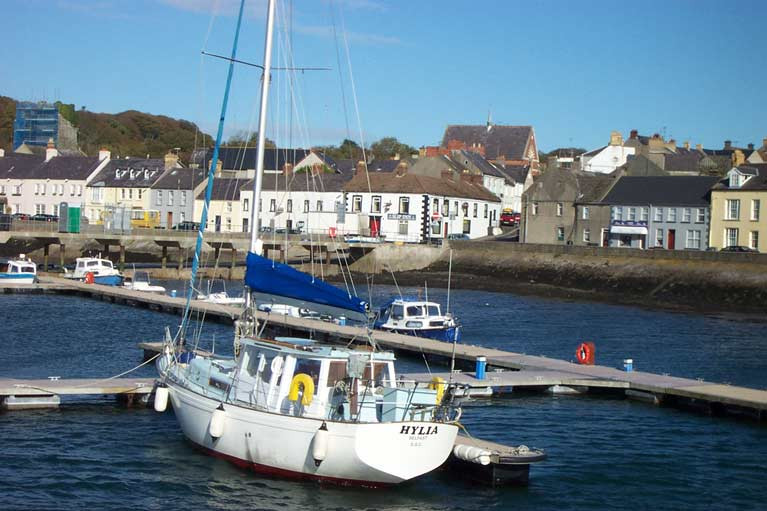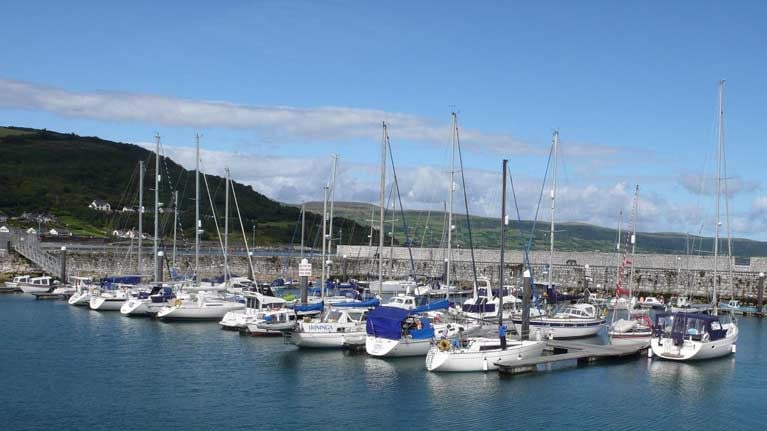Displaying items by tag: Marina
All Ten Irish Marinas Retain Blue Flag Status for 2022
All ten Irish marinas awarded in 2021 have retained Blue Flag status for the coming season.
85 Beaches and 10 marinas were awarded the Blue Flag for 2022 by Malcolm Noonan TD, Minister of State with responsibility for Heritage and Electoral Reform at a ceremony at Curracloe Beach in County Wexford this afternoon.
79 of the 83 beaches awarded in 2021 retained Blue Flag Status for the 2022 bathing season.
Download the details below as PDF files
Blue Flag Marinas Awarded for 2022
- County Name
- Cork Kinsale Yacht Club
- Cork The Royal Cork Yacht Club Marina
- Clare Kilrush Marina
- Donegal Greencastle Marina
- Donegal Rathmullan Marina
- Kerry Fenit Marina
- Kerry Portmagee Seasonal Pontoon
- Westmeath Quigley's Marina, Killinure Point
- Wexford Kilmore Quay Marina
- Wexford New Ross Marina
 Blue Flag status - The Royal Cork Yacht Club Marina in Cork Harbour Photo: Bob Bateman
Blue Flag status - The Royal Cork Yacht Club Marina in Cork Harbour Photo: Bob Bateman
Five beaches awarded in 2021 that have not been awarded for the 2022 season are: Bray South Promenade in Wicklow; Warren, Cregane Strand in Cork; Traught, Kinvara in County Galway; Carrowmore and Clare Island in County Mayo. None of these beaches achieved the “Excellent” water quality classification necessary to be awarded the Blue Flag. Each of the sites received a classification of “Good”, the second highest classification available based on an analysis of bathing water samples over the past four bathing seasons.
Speaking at the awards ceremony Minister Noonan stated that: "This year celebrates 35 years of the Blue Flag as an international programme and during that time the Blue Flag has become an internationally recognised symbol of high standards in water quality, environmental management, environmental education and safety. I am pleased to be presenting 95 blue flags and 62 green coast awards today and want to commend the great efforts made by local authorities, An Taisce, coastal communities and volunteers for their work around the country.
Mr. Ian Diamond, Coastal Awards Manager for An Taisce in announcing this year’s Blue Flag and Green Coast Award recipients stated:
"We were delighted to be welcomed to the Sunny Southeast today for the opportunity to celebrate the beaches and marinas awarded for the 2022 season. It takes a lot of hard work and dedication to manage a beach or marina to the excellent standards required by these award programmes. It’s been too long since we’ve had the opportunity to acknowledge these efforts in person, and I would like to thank all in attendance and our hosts Wexford County Council for helping us make today’s event worth the wait”.
Blue Flag
The Blue Flag is one of the world’s most recognised eco-labels. Originating in Frnace in 1985 it was launched as an International programme as part of the "European Year of the Environment in 1987. In 1988, the first year sites were awarded outside of France 19 beaches and 2 marinas received the Blue Flag in Ireland. 2022 is the 35th year that beaches and marinas have been awarded here in Ireland and the 95 beaches and marinas being awarded is the highest annual total to date.
The programme aims to raise environmental awareness and promote sound environmental management of beaches, marinas and eco-tourism boats around the world. The 85 Irish beaches and 10 marinas that have achieved this accolade must adhere to specific criteria related to water quality, information provision, environmental education, safety and site management.
Award highlights
- The number of sites receiving the award is up 2 on last year’s total.
- 7 beaches not awarded in 2021 have been awarded for the coming bathing season. These are: Trá Inis Oírr (Main Beach) in County Galway; Fountainstown and Youghal Front Strand in County Cork; Balcarrick, Donabate and Rush, South Beach in Fingal; Ballybunnion North Beach in Kerry and Ballymoney North Beach, in County Wexford.
- Trá Inis Oírr, the main beach on Inis Oirr in County Galway has been awarded a Blue Flag for the first time this year.
- In Cork, Fountainstown has been awarded for the first time since 1991 and the second time since Blue Flags were first awarded in Ireland.
- Youghal Front Strand in Cork will fly the Blue Flag for the first time since 2011.
- Balcarrick, Donabate in Fingal has been awarded a Blue Flag for the first time since 2016.
- Ballybunnion North Beach, which last flew a Blue Flag in 2019 has been awarded for the 2022 bathing season.
- Ballymoney North Beach, in County Wexford regains Blue Flag status having not been awarded in 2021.
- 79 of the 83 beaches awarded in 2021 retained Blue Flag Status for the 2022 bathing season.
- The 5 beaches awarded in 2021 that have not been awarded for the 2022 season are: Bray South Promenade in Wicklow; Warren, Cregane Strand in Cork; Traught, Kinvara in County Galway; Carrowmore and Clare Island in County Mayo. None of these beaches achieved the “Excellent” water quality classification necessary to be awarded the Blue Flag. Each of the sites received a classification of “Good”, the second highest classification available based on analysis of bathing water samples over the past four bathing seasons.
- All 10 marinas awarded in 2021 have retained Blue Flag status for the coming season.
The Irish Marine Federation (IMF) has welcomed the call by an international marina grouping to have marinas recognised as nautical tourism destinations and to be recognised officially alongside other tourist accommodation descriptions. as set out in the National Tourism Development Authority Act 2003.
"This would allow marinas to extend the same advantages of a low tax rate that the Government has allowed for other providers in the tourism sector", IMF Chairman Paal Janson says.
"The marina infrastructure is a vital part of the coastal community economic and social fabric and should be afforded the same support and encouragement that other tourism accommodation providers enjoy", Janson told Afloat.
ICOMIA Marinas Group (IMG), recently published a new policy paper on marina taxation, putting the spotlight on the number of taxes marinas pay and the disparity of the tax value when compared to other tourism outlets. It received input from ICOMIA’s partner, European Boating Industry (EBI), which is actively advocating on VAT and its application for the boating and nautical tourism sector at the EU level.
"Marinas are unquestionably essential for nautical tourism"
Unquestionably essential for nautical tourism and tourism in general, marinas should be treated in the same way as hotels and other hospitality accommodations. Based on a survey carried out by ICOMIA members it is known that 40% of the countries have a reduced VAT tax for hotels and/or campsites that is not applicable to marinas. Of all the countries where there is a different VAT rate for hotels and marinas, the difference between those two vary significantly and they range between 10% to 18%. This significant difference makes nautical tourism less attractive and is known to be a big barrier to the growth of the industry.
 Marinas, such as Ireland's largest at Dun Laoghaire Harbour pictured above, are not just resorts, they are clusters of companies, an attraction by themselves, a centre of activities and a hospitality infrastructure argues ICOMIA Photo: Afloat
Marinas, such as Ireland's largest at Dun Laoghaire Harbour pictured above, are not just resorts, they are clusters of companies, an attraction by themselves, a centre of activities and a hospitality infrastructure argues ICOMIA Photo: Afloat
Martinho Fortunato, IMG Chair said: “Marinas have proven to be a great booster to local economies and tourism. Marinas are not just resorts, they are clusters of companies, an attraction by themselves, a centre of activities and a hospitality infrastructure. They increase nautical tourism and nautical sports. Knowing all this, why aren’t marinas considered like that in terms of tax? Why don’t we have a bigger harmonization between activities and countries? These are the main reasons why the ICOMIA Marinas Group carried a survey among its members and developed the Policy Paper about marina taxation, a very important document for the future of our industry.”
Philip Easthill, EBI Secretary-General added: “EBI is advocating for a level playing field in the tourism sector at EU level which must include VAT rates to be adapted for the entire nautical tourism sector. This can further increase competitiveness and incentivise economic growth and jobs. We are delighted that our partner ICOMIA will also promote this globally in other regions through the policy paper on marina taxation.”
Neglecting the positive impacts of a lower and levelled VAT system applied to marinas signals for a poor understanding of the real social and economic impacts of nautical tourism in local communities, especially in countries with a big boating market potential.
ICOMIA recommends implementing policies that consider marinas as tourism organisations and as hotel-like infrastructures and therefore apply the same VAT charges. Looking ahead and for the long-term success of recreational boating and nautical tourism and its direct and indirect benefits, administrations are encouraged to work on harmonised tax policies for marinas.
Antrim Marinas & Harbours to Be Dredged Over Winter
Two marinas and two harbours in the Mid and East Antrim Council area will be dredged over the coming winter and following Spring. They are Carnlough Harbour and Glenarm Marina on the Antrim Coast Road and Carrickfergus Marina and Harbour on the north shore of Belfast Lough.
Carnlough Harbour will be closed from Monday 1st November until Friday 19th November 2021 and Carrickfergus Harbour from Thursday 24th March 2022 until Tuesday 17th May 2022.
 Carnlough Harbour
Carnlough Harbour
Glenarm Marina dates are from Friday 19th November until Thursday 16th December 2021 and Carrickfergus Marina will be dredged from Thursday 16th December 2021 until Thursday 24th March 2022. The marinas and harbours were due to be dredged as some areas are now below the minimum depths as per hydrographic surveys.
 Glenarm Marina Photo: Tourism NI
Glenarm Marina Photo: Tourism NI
The Council has warned that these dates are subject to movement based on contractual changes and effects of weather. A further notice to mariners will be issued if the programme changes.
The largest number of boats affected will be those berthed in Carrickfergus which has a capacity of 300. It was dredged in 2015. Glenarm has recently had extra berths added to make the total 50. Carnlough lies 16 miles south of Fair Head and is used mainly by pleasure boats and small fishing vessels.
 Carrickfergus Harbour Photo: Rossographer
Carrickfergus Harbour Photo: Rossographer
The contractors are the 192-year-old Charles Brand Ltd company based in Sydenham, Belfast and Foyle and Marine Engineering JV with HQ in Claudy, Co. Londonderry.
Karena Catterson, Maritime Development Officer at Carrickfergus Marina stated that Berth Holders were given various options for the period of dredging:
- They can lift their boat out and receive a full refund for their berthing during the dredging period and Council will pay 50% of their lift in and out costs.
- They can relocate to another marina of their choice for which Council will pay full costs. In cases where berthing fees are cheaper, the difference in costs will be refunded.
- They can remain in the marina and receive a 30% discount on their fees, and where it can be facilitated access will be granted for emergencies.
- Liveaboards will remain in the marina as normal.
Some boat owners have arranged to move to Bangor Marina where Kevin Baird, Harbour Master and Marina Manager, is making plans; “We are in the planning/berth allocation stage, and we know that some of those who have booked in with us will be arriving early. Hopefully, all goes to plan, and the weather stays calm to allow barges to dump at the designated spoil site”.
All Ten Irish Marinas Retain Blue Flag Status for 2021
All 10 marinas awarded a Blue Flag in 2020 have been awarded a Blue Flag for the coming season.
Of the 26 counties, four have two Blue Flags and two counties have one.
The International Blue Flag and Green Coast Award recipients for 2021 were announced by the Education Unit of An Taisce yesterday.
As Afloat reported, the number of Blue Flags awarded this season set a new record for the Republic of Ireland for beaches and marinas.
 Royal Cork Yacht Club Marina on the Owenabue river in Crosshaven in Cork Harbour has retained its Blue Flag for 2021 Photo: Bob Bateman
Royal Cork Yacht Club Marina on the Owenabue river in Crosshaven in Cork Harbour has retained its Blue Flag for 2021 Photo: Bob Bateman
The retention of Blue Flag status at both Kinsale Yacht Club and Royal Cork Yacht Club means that Cork has a total of 12 Blue Flag beaches and marinas a record annual haul for the rebel county.
Quigley's Marina, Killinure Point on the River Shannon in County West Meath has retained the Blue Flag awarded in 2020. Quigleys' Marina has been awarded every year since 2003.
The 10 marinas (from a coastal network of approximately 60 marinas and pontoons) that have achieved this accolade must adhere to specific criteria related to water quality, information provision, environmental education, safety and site management.
The Ten 2021 Irish Blue Flag Marinas are:
WEXFORD
- Kilmore Quay Marina
- New Ross: Three Sisters Marina
CORK
- Royal Cork Yacht Club
- Kinsale Yacht Club
KERRY
- Portmagee seasonal Visitors pontoon
- Fenti Marina
CLARE
- Kilrush Marina
WESTMEATH
- Quigley's Marina
DONEGAL
- Rathmullan Marina
- Greencastle Marina
Expanding its appeal as a staycation destination for boaters, guests and watersports enthusiasts, MDL Holidays introduces floating marine lodges to Mercury Yacht Harbour and Holiday Park’s growing list of attractions.
Fully equipped with a capacity of up to four guests, the first of the three beautifully crafted new self-contained marine lodges will be available at the end of April, just in time for the May Bank Holiday weekend.
“We’re delighted to be able to offer visitors to our Mercury Yacht Harbour and Holiday Park a really unique overnight experience,” says marina manager, Simon Cothill.
“Ideal for families or groups of friends, our stunning new floating lodges offer all the home comforts of a traditional short stay lodge or self-catering apartment, but with the thrill of waking up on the beautiful River Hamble, hearing the sounds of the water and the wildlife along the riverside.
 The marine lodges can be booked from £150 per night with a minimum of a two-night booking
The marine lodges can be booked from £150 per night with a minimum of a two-night booking
“The lodges are situated on the quiet northwest corner of the marina and are moored in the same way as vessels, using the cleats on the pontoons. It is truly a cabin berth experience for family and friends wanting to get out on the water together, or boaters who don’t have enough berths to accommodate everyone overnight.”
Overlooking Badnam Creek, the spectacular views of both the creek and the River Hamble can be enjoyed from the lodges’ open-air seated decking area created around the entrance to the marine lodge.
“With so many activities now available at the marina and holiday park, the new on water lodges means that anyone visiting for a sailing course, a paddleboarding adventure with the team at Wesup or dining at our onsite restaurant the Gaff Rigger can extend their stay, enjoying more time in the surrounding area and all that there is available,” continues Simon.
“We’re only a 20-minute walk from picturesque Hamble Village and its independent shops and variety of restaurants, and our riverside location lends itself to amazing walks and cycle rides. And with the marine lodges being fully insulated and having an air-conditioning and heating unit, they’re an ideal short stay staycation option all year round.”
Crafted by Trojan Timber Products, working in partnership with Intermarine, the new marine lodges are a bespoke design, created specifically for MDL to blend seamlessly into the marina and its tranquil surroundings.
The marine lodges can be booked via Hoseasons.co.uk and prices start from £150 per night with a minimum of a two-night booking.
Ireland Bids to Host ICOMIA 2023 World Marina Conference
The Irish Marine Federation (IMF) has made its first-ever bid to stage ICOMIA's World Marina Conference in Dublin in 2023.
The marine leisure trade body, that also represents Irish Marina Operators, is up against stiff competition from rival bids in Villamoura in Portugal and also Tampa, Florida.
Up to 400 delegates would be involved in the high-level conference that includes site visits to key Irish marina facilities.
If successful, the IMF wants to use the conference as both a showcase for the potential of the fledgeling Irish Marine industry to an international audience but also use the three-day event as a means of lobbying local government to support the domestic initiatives around the coast.
The Irish marine sector has developed from small-scale boat building and boat rentals to award-winning marinas, international pontoon manufacturers and a major hub for cruising boats and superyachts.
 IMF Chairman Paal Janson is leading the Irish bid to bring the World Marina Conference to Dublin in 2023
IMF Chairman Paal Janson is leading the Irish bid to bring the World Marina Conference to Dublin in 2023
The Irish bid, led by IMF Chairman Paal Janson, who is also General Manager of Ireland's biggest marina at Dun Laoghaire Harbour, has been supported by relevant Government Departments and other state agencies including Failte Ireland who assisted in the preparation of Ireland's presentation.
The Irish bidders are hoping that as many delegates will never have been to Ireland before there will be a 'Dublin city bounce' as the capital is a much sought after conference location.
Cove Saling Club’s brand new marina pontoons have been put to immediate use in Cork Harbour with yachts and motorboats occupying the new berths since the opening up of sailing activity on 8th June.
Coronavirus restrictions delayed the original expected completion date in April, but the berthing pontoons are fully assembled and connected to the gangway that was installed earlier this year.
 New Cove Marina
New Cove Marina
As previously reported on Afloat.ie, the Cork Harbour club has also been working on upgrades to its dinghy park facilities including a new meeting room, office and kitchen at Whitepoint in Cobh.
 Cove Sailing Club dinghy parking facilities Photo: Bob Bateman
Cove Sailing Club dinghy parking facilities Photo: Bob Bateman
Bangor Marina Ease COVID Restrictions on Belfast Lough
On 15th June the Northern Ireland Executive announced further relaxations to the Coronavirus Regulations and subsequently Bangor Marina updated its information yesterday on Northern Ireland Marinas and Harbours. These developments make some changes to the information here.
From 26th June, caravan parks, campsites and self-contained tourist accommodation will be able to reopen. With this in mind, the Marina believes that from 26th June, leisure boat owners should be able to overnight onboard their vessels. The same goes for Carrickfergus and Glenarm Marinas.
The position with Belfast, Ballycastle and Portrush remains the same - open to resident berth holders only, no visiting boats and no overnighting. Rathlin and the Copeland Islands remain closed. In Strangford Lough, Portaferry status is the same - open to resident and visiting boat owners, no overnighting until further notice. Further round the Down coast Ardglass is only open to resident berth holders only and no overnighting.
Isle of Man Marinas
Across the Irish Sea the Isle of Man borders are closed so there is no access to Peel, Ramsay, Port St Mary, Castletown, Port Erin, Douglas, Laxey, and Derby Haven. Vessels may transit through IOM waters and lie at anchor but you are not permitted to go ashore – you may be put into forced quarantine. On 20th March a 26-year-old arriving on the island by ferry was arrested for failing to self-isolate against Coronavirus. He faces a fine of up to £10,000 and a possible three-month jail sentence.
Scottish Marinas
In an update from Scotland, Portpatrick Harbour remains closed. The marinas at Troon, Largs, Rhu, Kip, Ardfern are open to residents only, no visitors at present, no overnighting. Harbour Master Kevin Baird adds “ We have been told that Scottish marinas and leisure harbours are expected to open 15th July (approx.) but this could change as they progress along the road to recovery”.
Welsh Marinas
And in Wales Aberystwyth, Conwy, Pwllheli, Milford, Neyland, Penarth, Cardiff and Swansea are open to residents only who live within a 5-mile radius of the marina site, no visitors at present, no overnighting. It is understood the Welsh Government plans to offer further guidance on the lifting of COVID19 restrictions.
The situation around the opening of marinas and harbours in Northern Ireland in COVID-19 appears fluid but the latest news is good for those wanting to relax, sail and visit.
Bangor Harbour Master Kevin Baird says that Bangor, Carrickfergus, and Glenarm marinas and harbours are open to visitors but for short stay only – no overnighting.
Also open to all are the Ards and North Down harbours but the Copeland Islands off Donaghadee are completely closed. Marinas and harbours in the Newry and Mourne Council areas are open on the same basis – short stay only.
Belfast Harbour Marina has confirmed that it is open for residents only.
Going north all the Causeway Coast and Glens Marinas and Harbours are now open but only to residents, with the exception of Rathlin Island. It will remain closed for in the short term to all vessels, including visitors. John Morton, Ballycastle Harbour Master, has clarified, “We are not open for any visiting vessels at this time, only resident ones. This will be reviewed over the coming weeks”.
In Strangford Lough, Portaferry Marina has been open for residents and visitors since 25th May but there is no news on Strangford town pontoon or on Foyle Marina in Derry.
The current Foyle Port website posts a Notice to Mariners stating that Foyle Port Marina is closed to visiting vessels and crafts. A further notice will be issued when the marina has re-opened to all.
On the subject of crews, Kevin Baird says, “ Our understanding is that groups of up to six people who do not share a household can meet up outdoors and onboard boats while maintaining social distancing, i.e. two metres”.
More Northern Ireland Marinas Reopen
As well as Bangor Marina opening, also nearly back to normal is Carrickfergus across Belfast Lough, Glenarm on the Antrim Coast Road and the inland marina at Portglenone on the River Bann.
In a Notice to Mariners Harbour Master Billy Withers from Carrickfergus said that Mid and East Antrim Harbours and Marinas are moving to the restoration of services and facilities. He goes on to reiterate that as elsewhere, health and safety of everyone involved are paramount and social distancing must be maintained.
The Notice states “We have spoken with Harbour Masters and Marina Managers from around Great Britain and Northern Ireland, considered the advice of the British Marine Federation, The UK Harbour Masters Association, RYA NI, and the Coastguard as well as consulting with health and safety staff”.
Boat owners will now be able to go to sea. This includes launching and recovery from the Council’s Harbours, Marinas, and slipways. The advice is that this is for a limited time and during daylight hours (3-4 hours maximum is recommended). Belfast Coastguard should be notified on leaving and returning to the harbour/marina/slipway. At this stage boats from outside the Mid & East Antrim harbours/marinas will not be able to access the facilities. Overnighting on board is not permitted at this stage unless it is the owner’s permanent residence.
The details on access to the Marina are clear:- Priority should be given to berth holders coming up the main access ramps ie exiting. At this stage the Marinas will be open between 8am and 8pm every day. However, the number going to any one boat should be limited. The Marina reserves the right to limit the number of people on the pontoons if social distancing is not being observed or not possible. Access is currently by the buzzer on the gate. It is hoped that fob access will be restored by next week at the latest to all those who have returned contracts. The West Gate, adjacent to the Windrose, remains closed.
The marina reception will remain closed in the meantime, but please telephone, radio, email the office for any enquiries as staff are available during normal office hours.
Toilets, Wash Hand Basins & Showers
The toilets, urinals, wash hand basins and showers have been opened in the berth holder facilities, however please do not use the individual units that have been cordoned off to create more space between users.
On the Pontoons
When passing on the pontoons, practice safe navigation, port to port and pass well clear, using the pontoon fingers to get that extra clearance distance.
Contractors Working On Site
If a berth holder requires a contractor to conduct work on a boat, then it is down to him/her to ensure that they and the contractor observe social distancing and that the contractor has adequate PPE.
Authorised contractors are required to contact the marina office in advance.
RYA Guidance which is widely publicised and should be adhered to.
Other Considerations to Minimise the Risk of Transfer of virus.
Berth holders must take responsibility for their own safety and this now includes using PPE where appropriate. To minimise the risk of any transfer and berth holders are urged to maintain high levels of hygiene on their boats and especially when using taps, hoses, rails, gates etc. on the pontoons and entrances.
The situation will continue to be regularly monitored in line with government guidelines, and advice and communications that we are receiving from the British Marine Federation, the UK Harbour Masters Association and RYA NI.





























